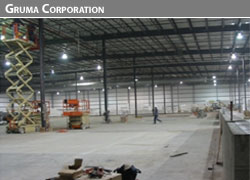

Case Study: Gruma Corporation

Market Opportunity
The Gruma food processing facility is one of the largest tortilla production plants in the United States, producing approximately 16 million tortillas a day for the Mission Foods brand. This Commerce plant operates 24 hours a day throughout the year. At the time of acquisition in 1998, Gruma was nearing the end of a long-term lease and was strongly considering relocation to a more modern facility that could meet its growing production and distribution needs. This presented a challenge for Magellan, which wanted to retain a credit tenant, but also created an opportunity to add value for both parties.
Adding Value
Magellan responded with a build-to-suit plan that called for demolishing a 27,000 SF grade-level service and office facility, and building a new 50,000 SF industrial warehouse attached to the existing 150,000 SF food processing plant. Increased density, combined with the higher market rents commanded by institutional quality warehouse space, was at the core of Magellan's value-add strategy. Magellan was confident that Gruma's large capital investment in its existing plant, combined with the functionality of 50,000 SF of distribution space to address their expansion requirements, would preclude Gruma from moving and provide for a “win-win” opportunity.
Results
In 1999, Gruma decided to remain in Commerce and signed a new ten-year lease at significantly higher rents on both buildings. The subsequent design and construction required an experienced team to handle the complexities of building adjacent to the existing operations of Mission Foods. The project was successfully executed and Mission Foods has continued to thrive in its expanded facility.
Magellan's redevelopment plan added value for both the tenant and the investor. Gruma benefited from an expanded, more efficient manufacturing and distribution facility without relocation costs or disruption to production, and Magellan retained a good credit tenant while increasing density and achieving market rents.
In November of 2002, the facility was sold for $12.9 million, with a total project cost of $10.5 million. Rental revenues were increased by 58% and the sale achieved a gross profit margin on equity of 61%. In recognition of the project's success, it was included as a case study in the Urban Land Institute's (ULI) Professional Real Estate Development: The ULI Guide to Business (2003).


